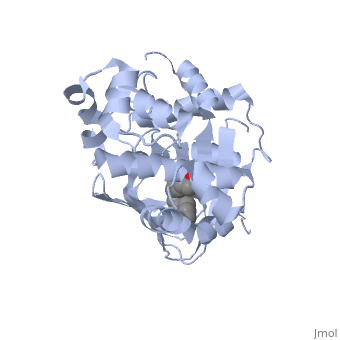ToxT
From Proteopedia
(Difference between revisions)
| Line 7: | Line 7: | ||
==Other Structural Features== | ==Other Structural Features== | ||
| - | <u>DNA-binding</u>. ToxT belongs to a family of transcriptional regulators headed by and known as AraC.<ref name="structure">PMID: 20133655</ref> The AraC family is characterized by a 100 amino acid region of sequence similarity that forms a <scene name='ToxT_Transcriptional_Regulator_in_Vibrio_cholerae/Two_hth_domains/1'>DNA-binding domain</scene> with two helix-turn-helix motifs (helix in blue, turn in teal). <ref name="arac">PMID: 11282467</ref> The two HTH regions are linked by a very polar alpha helix (shown in black). The overall domain is composed of seven alpha helices, and is located at the C-terminus.<ref name="structure">PMID: 20133655</ref> | + | <u>DNA-binding</u>. ToxT belongs to a family of transcriptional regulators headed by and known as AraC.<ref name="structure">PMID: 20133655</ref> The AraC family is characterized by a 100 amino acid region of sequence similarity that forms a <scene name='ToxT_Transcriptional_Regulator_in_Vibrio_cholerae/Two_hth_domains/1'>DNA-binding domain</scene> with two helix-turn-helix motifs (helix in blue, turn in teal). <ref name="arac">PMID: 11282467</ref> The two HTH regions are linked by a very polar alpha helix (shown in black). The overall domain is composed of seven alpha helices, and is located at the C-terminus.<ref name="structure">PMID: 20133655</ref> Assuming ToxT is similar in mechanism to other AraC proteins, helix six from HTH1 and helix nine from HTH2 become aligned with the help of helix seven (the polar linking region) to allow binding to major consecutive grooves of target DNA.<ref name="structure">PMID: 20133655</ref>. The conformation of helix seven is dependent on the ligand bound. |
<br/> | <br/> | ||
<br/> | <br/> | ||
<u>Ligand-binding</u>. <scene name='ToxT_Transcriptional_Regulator_in_Vibrio_cholerae/Barrel/1'>A nine-stranded beta sheet sandwich</scene> or "jelly-roll" with three other alpha helices (overall making up the <scene name='ToxT_Transcriptional_Regulator_in_Vibrio_cholerae/N-terminus/1'>N-terminus</scene>) contain a <scene name='ToxT_Transcriptional_Regulator_in_Vibrio_cholerae/Binding_pocket/1'>binding pocket</scene>. This is largely made up of residues from the N-terminus (Y12, Y20, F22, L25, I27, K31, F33, L61, F69, L71, V81, and V83), and a few from the C-terminus (I226, K230, M259, V261, Y266, and M269). The pocket is highly hydrophobic, and has a known volume of 780.9 Angstroms.<ref name="structure">PMID: 20133655</ref> This pocket contains a ligand: <scene name='ToxT_Transcriptional_Regulator_in_Vibrio_cholerae/Binding_pocket/2'>cis-palmitoleate</scene> <ref name="structure">PMID: 20133655</ref> which appears to have a negative effect on virulence when present in vitro. The <i>cis</i>-palmitoleate forms <scene name='ToxT_Transcriptional_Regulator_in_Vibrio_cholerae/Salt_bridges_pam/1'>salt bridges</scene> with residues K31 and K230. This unsaturated fatty acid, like other UFAs,[http://en.wikipedia.org/wiki/Fatty_acid#Unsaturated_fatty_acids] tend to inhibit genes under the control of ToxT. The | <u>Ligand-binding</u>. <scene name='ToxT_Transcriptional_Regulator_in_Vibrio_cholerae/Barrel/1'>A nine-stranded beta sheet sandwich</scene> or "jelly-roll" with three other alpha helices (overall making up the <scene name='ToxT_Transcriptional_Regulator_in_Vibrio_cholerae/N-terminus/1'>N-terminus</scene>) contain a <scene name='ToxT_Transcriptional_Regulator_in_Vibrio_cholerae/Binding_pocket/1'>binding pocket</scene>. This is largely made up of residues from the N-terminus (Y12, Y20, F22, L25, I27, K31, F33, L61, F69, L71, V81, and V83), and a few from the C-terminus (I226, K230, M259, V261, Y266, and M269). The pocket is highly hydrophobic, and has a known volume of 780.9 Angstroms.<ref name="structure">PMID: 20133655</ref> This pocket contains a ligand: <scene name='ToxT_Transcriptional_Regulator_in_Vibrio_cholerae/Binding_pocket/2'>cis-palmitoleate</scene> <ref name="structure">PMID: 20133655</ref> which appears to have a negative effect on virulence when present in vitro. The <i>cis</i>-palmitoleate forms <scene name='ToxT_Transcriptional_Regulator_in_Vibrio_cholerae/Salt_bridges_pam/1'>salt bridges</scene> with residues K31 and K230. This unsaturated fatty acid, like other UFAs,[http://en.wikipedia.org/wiki/Fatty_acid#Unsaturated_fatty_acids] tend to inhibit genes under the control of ToxT. The | ||
| - | Specifically, the <i>cis</i>-palmitoleate appears to bind directly to ToxT, change its conformation, and thus lower the ability to bind DNA and form dimers.<ref name="structure">PMID: 20133655</ref> The presence of UFAs is associated with being in the lumen of the intestine during the bacterial infection. Here, binding of PAM brings K31 and K230 together and essentially closes off ToxT. In lower concentration of fatty acids, ie: after penetrating the intestine's mucus, the two lysine residues repel each other and give ToxT an open conformation, allowing | + | Specifically, the <i>cis</i>-palmitoleate appears to bind directly to ToxT, change its conformation, and thus lower the ability to bind DNA and form dimers.<ref name="structure">PMID: 20133655</ref> The presence of UFAs is associated with being in the lumen of the intestine during the bacterial infection. Here, binding of PAM brings K31 and K230 together and essentially closes off ToxT. K230 is at the end of helix seven, and binding to K31 causes pulling helix six into an unfavorable conformation that disallows DNA binding. In lower concentration of fatty acids, ie: after penetrating the intestine's mucus, the two lysine residues repel each other and give ToxT an open conformation by giving helix seven and thus six freedom, allowing DNA binding.<ref name="structure">PMID: 20133655</ref> |
<br/> | <br/> | ||
<br/> | <br/> | ||
Revision as of 18:20, 29 November 2011
The crystal structure of ToxT is resolved in monomeric form, after isolation from Vibrio cholerae strain O395.[1]
Introduction
ToxT is a molecule at the end of a transcriptional cascade that autoregulates the transcription of the primary virulence factors of Vibrio cholerae[1] and itself. These two factors, cholera toxin (CT)[2] and the toxin co-regulated pilus (TCP), are instrumental in causing the disease cholera[3]. This is an intestinal infection resulting in massive water loss in the affected individual, causing extreme dehydration.[4]
| |||||||||||
References
- ↑ 1.0 1.1 1.2 1.3 1.4 1.5 1.6 1.7 Lowden MJ, Skorupski K, Pellegrini M, Chiorazzo MG, Taylor RK, Kull FJ. Structure of Vibrio cholerae ToxT reveals a mechanism for fatty acid regulation of virulence genes. Proc Natl Acad Sci U S A. 2010 Feb 16;107(7):2860-5. Epub 2010 Feb 1. PMID:20133655
- ↑ Martin RG, Rosner JL. The AraC transcriptional activators. Curr Opin Microbiol. 2001 Apr;4(2):132-7. PMID:11282467
- ↑ Weber GG, Klose KE. The complexity of ToxT-dependent transcription in Vibrio cholerae. Indian J Med Res. 2011 Feb;133(2):201-6. PMID:21415495
- ↑ Shakhnovich EA, Hung DT, Pierson E, Lee K, Mekalanos JJ. Virstatin inhibits dimerization of the transcriptional activator ToxT. Proc Natl Acad Sci U S A. 2007 Feb 13;104(7):2372-7. Epub 2007 Feb 5. PMID:17283330 doi:10.1073/pnas.0611643104
Proteopedia Page Contributors and Editors (what is this?)
Ingrid Youngworth, Yang Yang, Michal Harel, Alexander Berchansky, Jaime Prilusky

